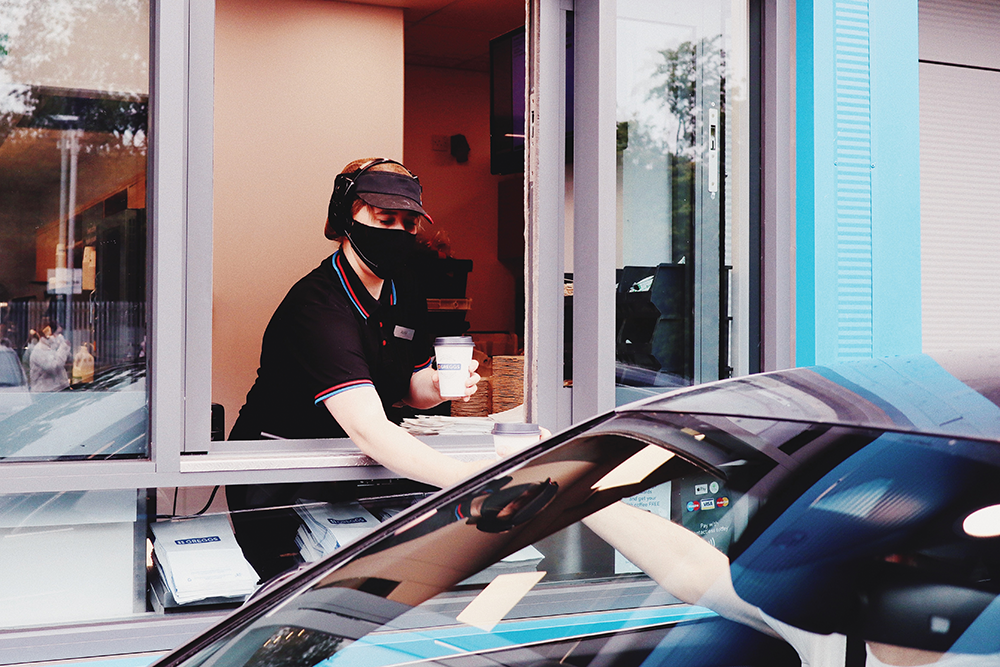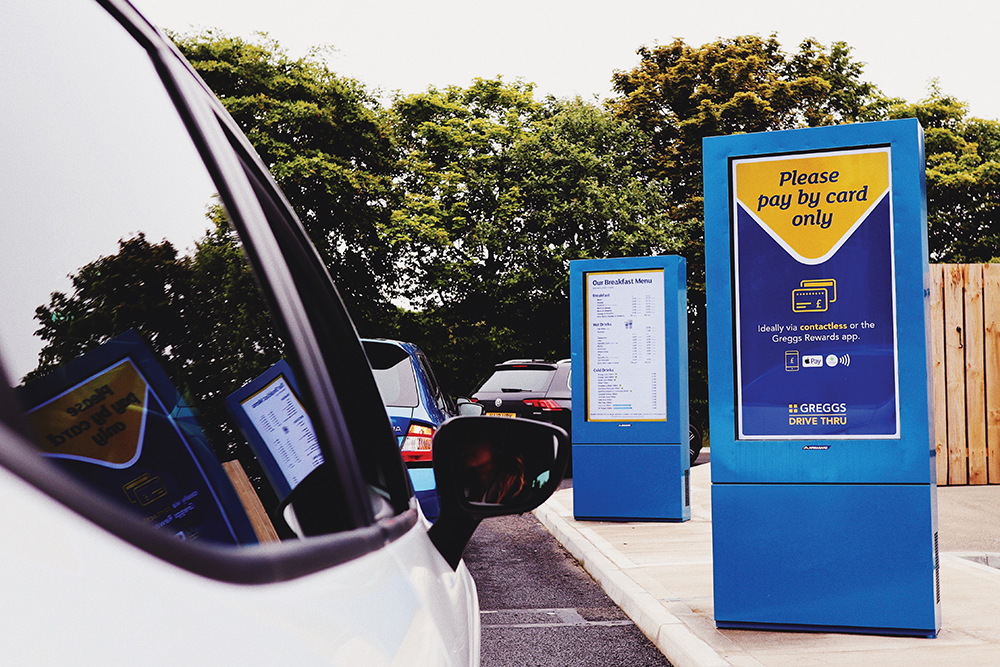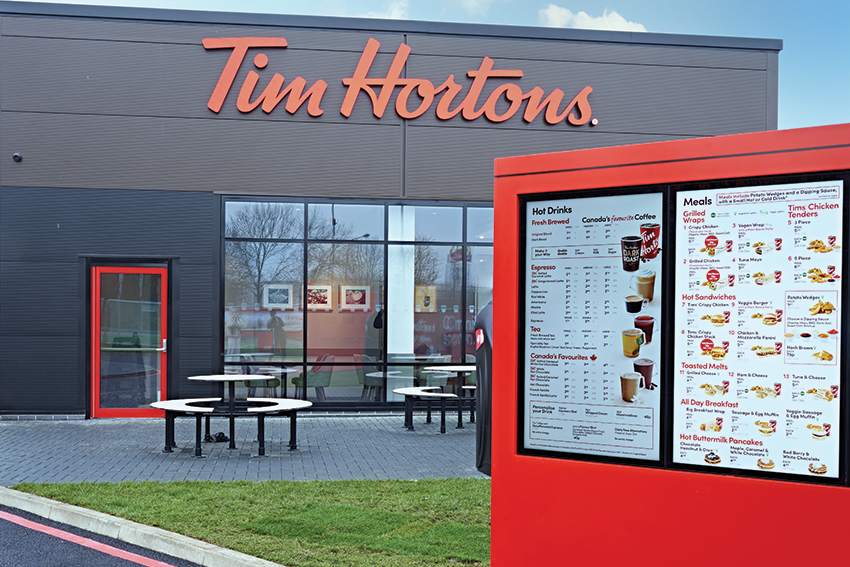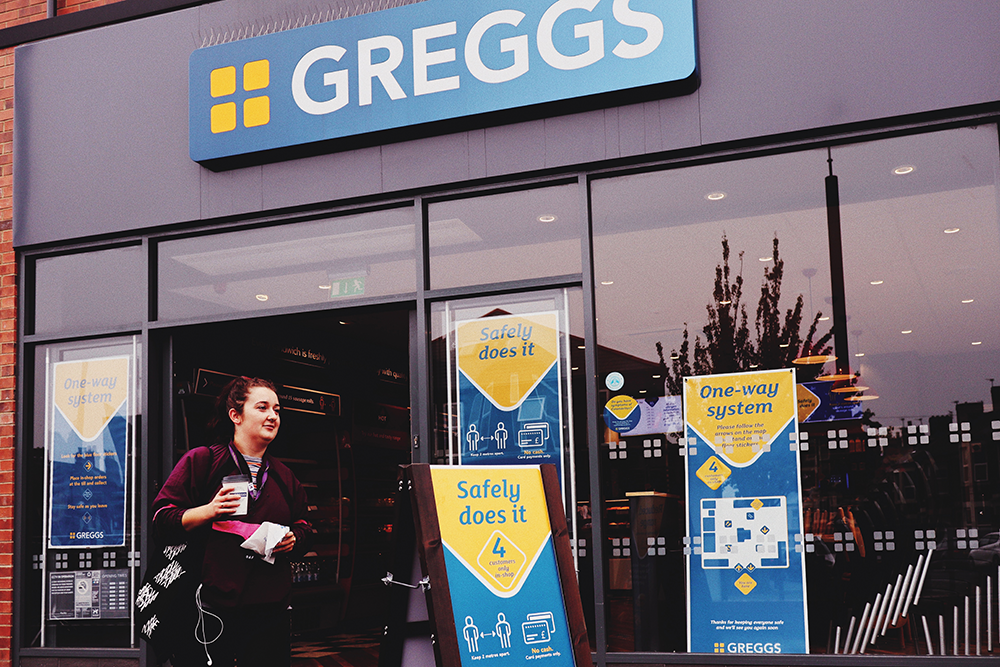Declines in food-to-go and foodservice as a result of the COVID-19 pandemic are forcing convenience and forecourt retailers to consider new business models to bring customers back into the store, and drive-thru and delivery are quickly emerging as the strongest contenders.
The IGD predicted the U.K. food-to-go market would decline 43% to £10.8 billion (US$14.8 billion) in 2020, a £8.1 billion decrease compared with 2019, and will continue to be impacted by COVID-19 during the next three years. In the medium to long term, IGD anticipates food-to-go specialists and coffee shops to be impacted most as they are typically located in city centers and transport hubs with footfall dependent on office workers, commuters and tourists.
Global Data agrees. Interviewed for Shop Talk LIVE, consulting director Mark Dempsey reported foodservice was in double-digit decline in every region and channel, including convenience and forecourt retail, during 2020. Further, its recent survey found one-third of global consumers expect to continue to work from home in the future, posing a further risk to footfall and car traffic. Those trends are encouraging retailers to think differently about their site configurations and store locations, with drive-thru and pickup-only c-stores enabling reduced interaction with staff and foodservice.

 Tim Hortons (top) so far has 10 locations with drive-thrus in the U.K. Greggs (bottom) has six drive-thru locations and says the average transaction value is 25% higher than in its shops.
Tim Hortons (top) so far has 10 locations with drive-thrus in the U.K. Greggs (bottom) has six drive-thru locations and says the average transaction value is 25% higher than in its shops.
As the U.K. entered its third lockdown on January 6, 2021, McDonald’s set the tone with the announcement it was changing the way it operates: Its restaurants across the U.K. and Ireland would remain open for drive-thru and McDelivery, but dine in and walk-in takeaway would be temporarily closed “while we review and verify any additional enhanced safety measures for these services.”
Reporting the same week, the bakery chain Greggs forecast its first annual loss after a £300-million-plus sales slump due to the pandemic and indicated that it did not expect to return to profit until 2022. Chief Executive Roger Whiteside said the impact of COVID-19 has been “enormous,” but the business established working practices that allowed it to provide takeaway foodservice under the different levels of restrictions. These include a partnership with Just Eat to offer delivery services, which will be extended from 600 shops to 800 in 2021.
Greggs has six drive-thru locations—two company-owned sites and four operated by franchise partners. Greggs opened one of its first drive-thru stores at EG Group’s multi-lane drive-thru site at Frontier Park, Blackburn, U.K., in November 2018. Alongside Greggs, there’s a double-lane KFC drive-thru and Starbucks drive-thru. According to Ilyas Munhsi, group commercial director, EG Group, Greggs has not previously considered a drive-thru format, but its competitive bakery and fresh food offer proved to be popular with customers. Greggs revealed the average transaction value at this format was 25% higher than in shops. The top-selling product in drive-thru is a sausage roll, followed by coffee.
The NPD Group found that drive-thru restaurant usage soared from September to November 2020. The global information company found there were 121 million visits to Britain’s 2,000 QSRs offering drive-thru in those three months—a 14% increase over the same period last year. Spend, meanwhile, was up a whopping 45% to £723 million as consumers placed larger-than-average orders at the drive-thru window.
In November (the U.K. entered a second four-week lockdown on November 5, 2020), drive-thru visits reached 37 million, a 27% increase over November 2019, with spend up 73% to £213 million. Dinner and treating occasions were the main beneficiaries, with dinner 20% more important compared to pre-COVID-19 levels, and treating occasions were up 47% as consumers looked to relieve the boredom of lockdown, researchers found.
For the month of November, drive-thru visits reached 37 million, a 27% increase over November 2019.
While drive-thru is not new to Britain—chains such as McDonald’s, KFC, Burger King and Greggs have all been busy opening drive-thrus in out-of-town locations and motorway service stations during the past few years—coffee chains, including Costa Coffee, Starbucks and Tim Hortons, are getting in on the act to expand their reach beyond the high street, where footfall is in decline.
Drive-thru restaurants are a big part of Tim Horton’s expansion plans, according to the company’s U.K. and Ireland retail brand manager Megan Trimble. The chain is planning to open a drive-thru restaurant in every major town and city throughout the U.K. by 2022. The minimum size is 2,400 square feet.
“Currently, we have an estate in the U.K. of 26 restaurants, 10 of which have drive-thru order points,” she said. “We have also got two new restaurants due to open in the coming months, both of which will also be drive-thru locations, taking us to 12 out of 28 restaurants—closing in on 50%.” The drive-thru menu is the same as in-store and offers full breakfast, lunch and evening meals, plus a donuts range.
 Tim Hortons’ drive-thru menu is the same as in-store and offers full breakfast, lunch and evening meals, plus a donuts range.But it’s not just coffee chains. QSR chains including Subway, Taco Bell and Krispy Kreme are opening drive-thru formats, and The NPD Group reports that in the three-month period between September and November 2020, drive-thru accounted for 11% of all eating out visits at QSRs and 12% of spend, both up sharply versus a year ago.
Tim Hortons’ drive-thru menu is the same as in-store and offers full breakfast, lunch and evening meals, plus a donuts range.But it’s not just coffee chains. QSR chains including Subway, Taco Bell and Krispy Kreme are opening drive-thru formats, and The NPD Group reports that in the three-month period between September and November 2020, drive-thru accounted for 11% of all eating out visits at QSRs and 12% of spend, both up sharply versus a year ago.
Dominic Allport, insights director (foodservice), The NPD Group, said: “There’s no question that the popularity of drive-thru in Britain has had a boost from COVID-19 as people tend to feel safer and more secure in their cars. Ordering in advance via an app, and a contactless experience at the window, offers additional reassurance to drivers and their passengers.”
Delivery Versus Drive-Thru
QSR delivery accounts for £1.6 billion, or 27% of total QSR spend, more than double that of QSR drive-thru (12% of total QSR spend), but the latter’s popularity with consumers suggests it will grow, The NPD Group reports. Researchers expect QSR chains will continue to open drive-thrus, as sites are generally cheaper than on the high street, and planning permission is typically easier to obtain. In addition, it is likely that drive-thrus allow restaurant chains to keep more revenue and profits compared to delivery, where commission is often paid to a third party, it said.
 Greggs worked out a plan to provide takeaway foodservice during the lockdowns, including partnering with Just Eat, a delivery service.
Greggs worked out a plan to provide takeaway foodservice during the lockdowns, including partnering with Just Eat, a delivery service.
Admittedly, Britain still has a long way to go to catch up with the dominance of drive-thru in the U.S., where there were 4.7 billion QSR drive-thru visits in the three months to November, which equates to 42% of all QSR visits—a share that is almost four times bigger than the Great Britain equivalent. Unlike Britain, drive-thru is far bigger than home delivery, accounting for 38% of total spend in the three-month period versus delivery, which accounted for 12% of total spend.
As the drive-thru grows in popularity across Britain, new operators are entering the market and expanding the menu on offer beyond traditional fast food and coffee. Restaurant brand @pizza is launching freshly cooked pizza shipping container drive-thrus in seven U.K. retail park locations, capable of making up to 10 perfectly cooked pizzas per minute via high-tech conveyor ovens. Customers will be able to order via an app with the option of collection or delivery to their vehicle.
In London, meanwhile, British meat alternative brand Meatless Farm launched a plant-based pop-up drive-thru and walk-thru in London in August 2020; while the craft beer brand Brewdog launched a beer drive-thru service through its bars last year with orders placed via the BrewDog Hop Drop app. The NPD Group said it expects to see more drive-thrus offer an increasingly varied range of cuisines, including Pan Asian and Indian food to meet the desire for spicy foods.
Allport said: “The format is not new to some of the major foodservice operators like McDonald’s, who have long used drive-thru as a complement to their high street and delivery offerings. However, for the coffee chains, drive-thru offers a distinct area of growth to help compensate for reduced footfall on high streets up and down the country.”
The popularity of drive-thru in Britain has had a boost from COVID-19 as people tend to feel safer and more secure in their cars.
The IGD agrees and believes QSRs will be one of the more resilient food-to-go channels moving forward, as it offers a value option for financially stretched consumers, while drive-thru and delivery offers have enabled the sector to adapt to local lockdown restrictions.
Changes in consumer behavior during the pandemic offer up opportunities, but food-to-go businesses need to be quick to grab them, states Nicola Knight, senior food-to-go analyst at IGD. “Well-developed digital loyalty, communications and ordering systems have a real role to play for businesses looking for an edge. Engaging with customers in this way should also help retailers to understand where the demand has moved to if city centers and transport hubs continue to lose footfall,” she said.
“Delivery should also continue to form a part of retailer and operator strategies, particularly if local lockdowns progress,” she added. “To offset the price of third-party delivery charges many operators are moving to delivery-only dark kitchens with lower overheads.”
Dempsey also referenced the trend of dark or ghost kitchens, which are changing the face of retail and providing an opportunity for c-stores. In the U.S., Kroger is trialing how to use back-office areas as foodservice distribution hubs to service the local community, reaching tens of thousands in the way some foodservice outlets might not be able. While in Ireland, Musgrave’s foodservice arm is trialing dark kitchens with two restaurants at a convenience store and at one of its food emporiums.
“We really do see every leading QSR player now moving into dark kitchen operations, even McDonald’s in the U.K.,” Dempsey said. “This really appears to be quite the way forward.”